基于可穿戴传感器的躯干参考点选取分析
陈玲 江红霞 刘基宏
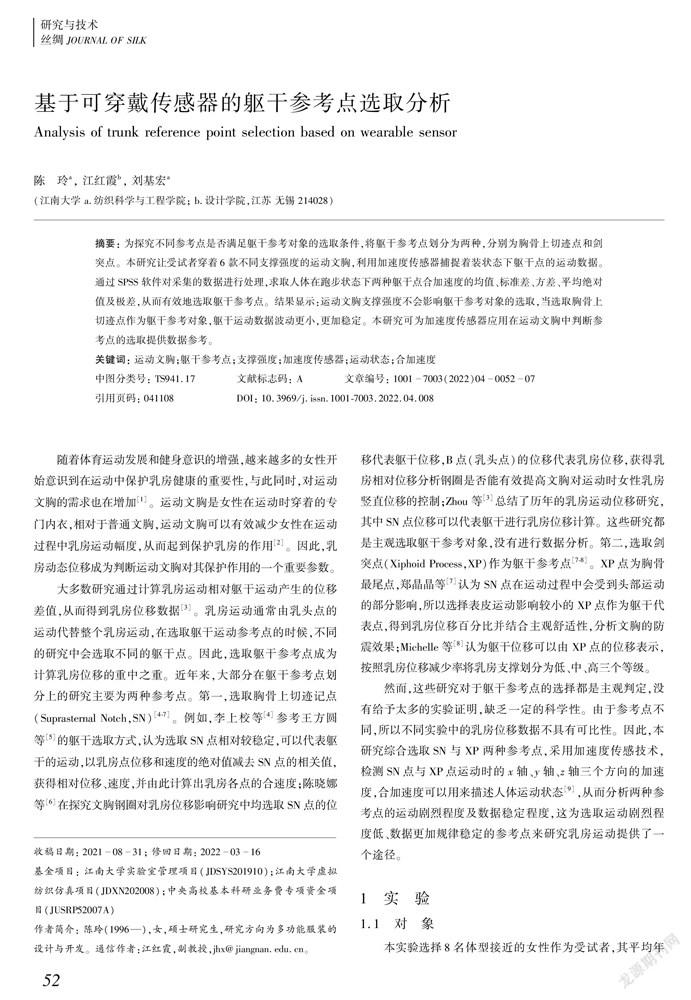
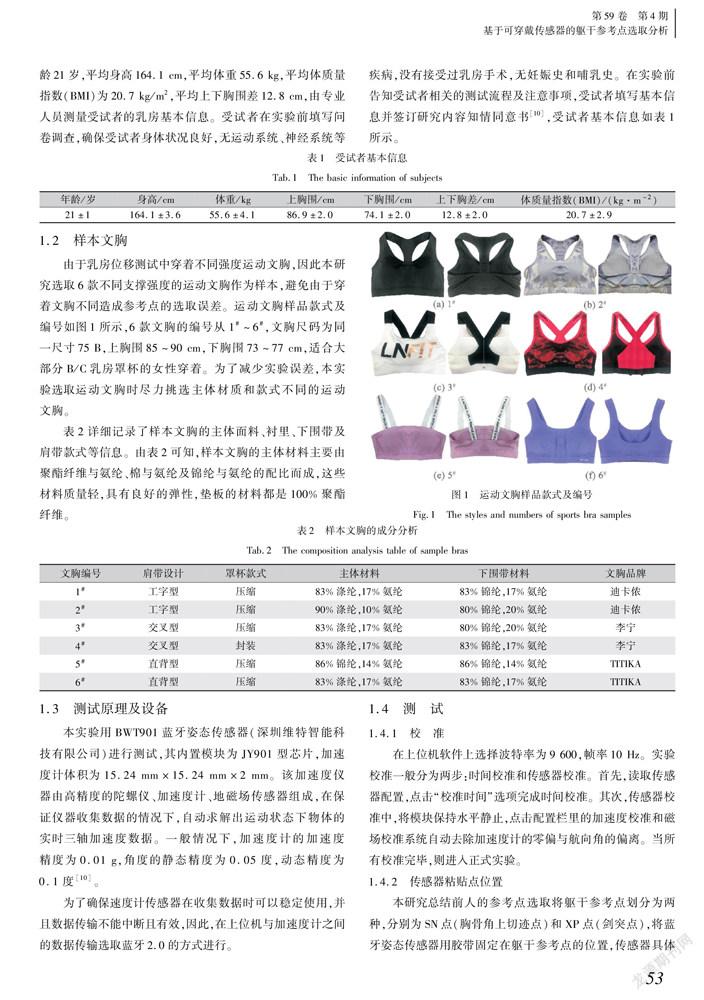

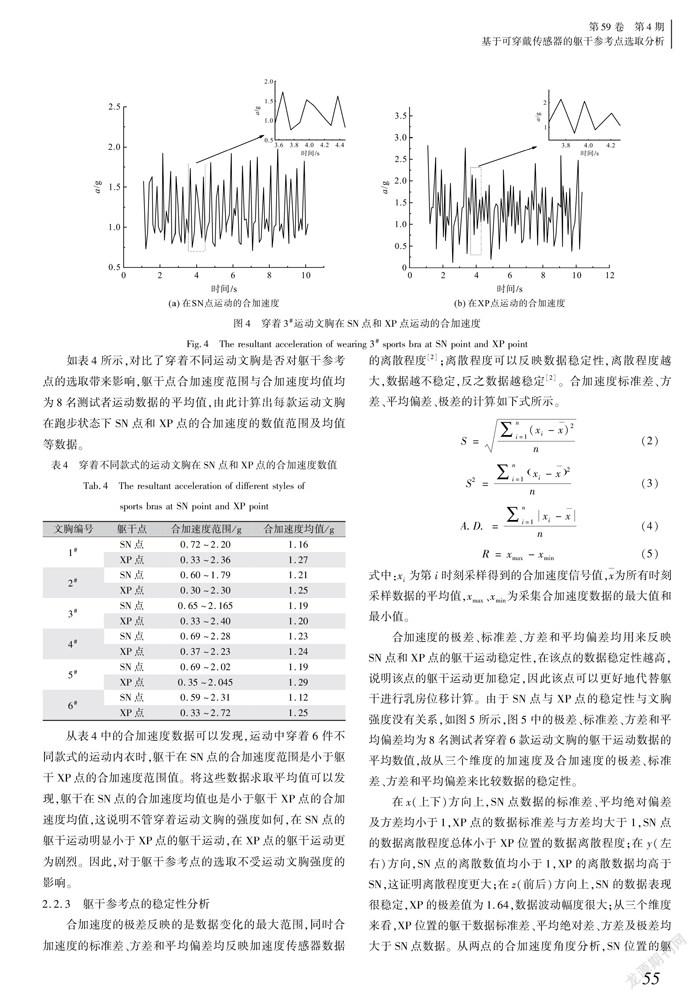

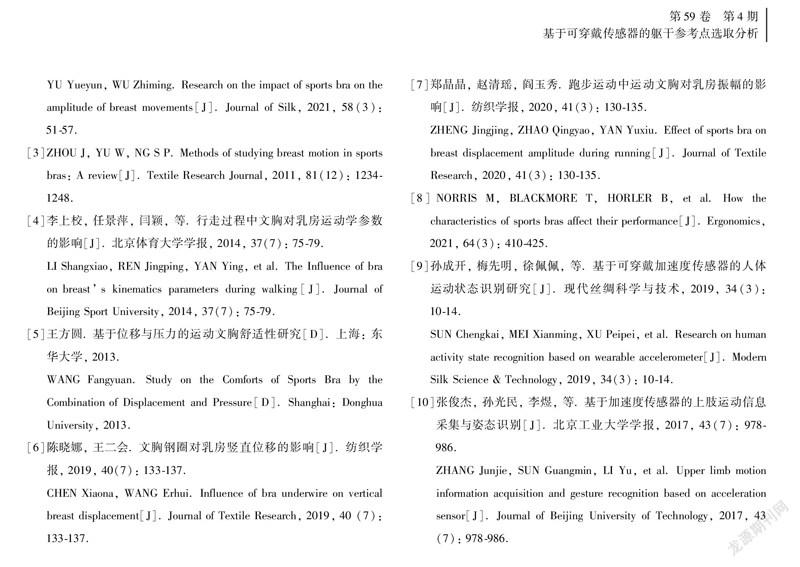
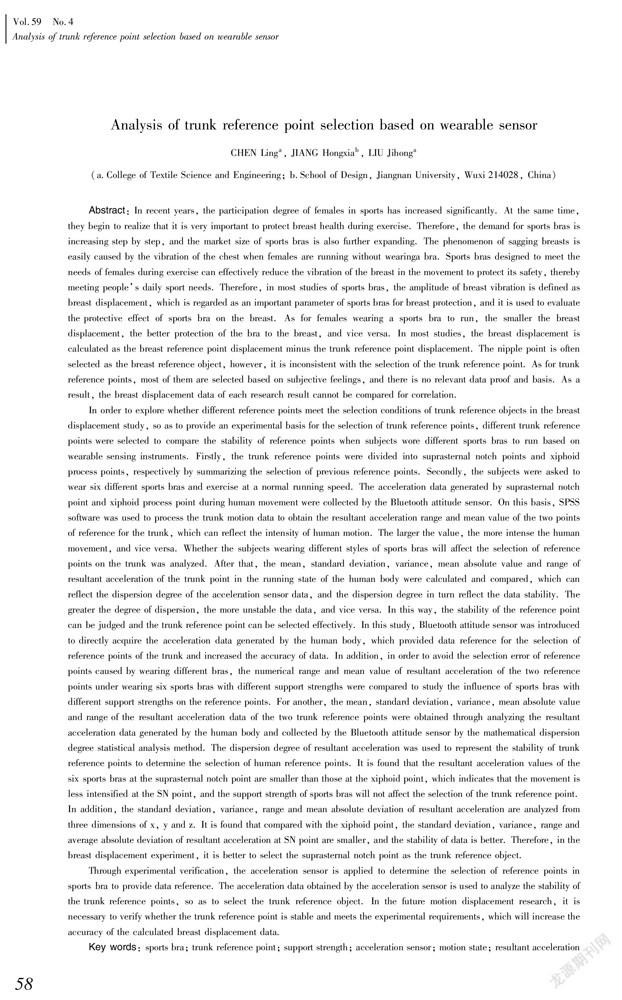
摘要: 为探究不同参考点是否满足躯干参考对象的选取条件,将躯干参考点划分为两种,分别为胸骨上切迹点和剑突点。本研究让受试者穿着6款不同支撑强度的运动文胸,利用加速度传感器捕捉着装状态下躯干点的运动数据。通过SPSS软件对采集的数据进行处理,求取人体在跑步状态下两种躯干点合加速度的均值、标准差、方差、平均绝对值及极差,从而有效地选取躯干参考点。结果显示:运动文胸支撑强度不会影响躯干参考对象的选取,当选取胸骨上切迹点作为躯干参考对象,躯干运动数据波动更小,更加稳定。本研究可为加速度传感器应用在运动文胸中判断参考点的选取提供数据参考。
关键词: 运动文胸;躯干参考点;支撑强度;加速度传感器;运动状态;合加速度
中图分类号: TS941.17文献标志码: A文章编号: 10017003(2022)04005207
引用页码: 041108DOI: 10.3969/j.issn.1001-7003.2022.04.008(篇序)
随着体育运动发展和健身意识的增强,越来越多的女性开始意识到在运动中保护乳房健康的重要性,与此同时,对运动文胸的需求也在增加[1]。运动文胸是女性在运动时穿着的专门内衣,相对于普通文胸,运动文胸可以有效减少女性在运动过程中乳房运动幅度,从而起到保护乳房的作用[2]。因此,乳房动态位移成为判断运动文胸对其保护作用的一个重要参数。
大多数研究通过计算乳房运动相对躯干运动产生的位移差值,从而得到乳房位移数据[3]。乳房运动通常由乳头点的运动代替整个乳房运动,在选取躯干运动参考点的时候,不同的研究中会选取不同的躯干点。因此,选取躯干参考点成为计算乳房位移的重中之重。近年来,大部分在躯干参考点划分上的研究主要为两种参考点。第一,选取胸骨上切迹记点(Suprasternal Notch,SN)[4-7]。例如,李上校等[4]参考王方圆等[5]的躯干选取方式,认为选取SN点相对较稳定,可以代表躯干的运动,以乳房点位移和速度的绝对值减去SN点的相关值,获得相对位移、速度,并由此计算出乳房各点的合速度;陈晓娜等[6]在探究文胸钢圈对乳房位移影响研究中均选取SN点的位移代表躯干位移,B点(乳头点)的位移代表乳房位移,获得乳房相对位移分析钢圈是否能有效提高文胸对运动时女性乳房竖直位移的控制;Zhou等[3]总结了历年的乳房运动位移研究,其中SN点位移可以代表躯干进行乳房位移计算。这些研究都是主观选取躯干参考对象,没有进行数据分析。第二,选取剑突点(Xiphoid Process,XP)作为躯干参考点[7-8]。XP点为胸骨最尾点,郑晶晶等[7]认为SN点在运动过程中会受到头部运动的部分影响,所以选择表皮运动影响较小的XP点作为躯干代表点,得到乳房位移百分比并结合主观舒适性,分析文胸的防震效果;Michelle等[8]认为躯干位移可以由XP点的位移表示,按照乳房位移减少率将乳房支撑划分为低、中、高三个等级。
然而,这些研究对于躯干参考点的选择都是主观判定,没有给予太多的实验证明,缺乏一定的科学性。由于参考点不同,所以不同实验中的乳房位移数据不具有可比性。因此,本研究综合选取SN与XP两种参考点,采用加速度传感技术,检测SN点与XP点运动时的x轴、y轴、z轴三个方向的加速度,合加速度可以用来描述人体运动状态[9],从而分析两种参考點的运动剧烈程度及数据稳定程度,这为选取运动剧烈程度低、数据更加规律稳定的参考点来研究乳房运动提供了一个途径。
1实验
1.1对象
本实验选择8名体型接近的女性作为受试者,其平均年龄21岁,平均身高164.1 cm,平均体重55.6 kg,平均体质量指数(BMI)为20.7 kg/m,平均上下胸围差12.8 cm,由专业人员测量受试者的乳房基本信息。受试者在实验前填写问卷调查,确保受试者身体状况良好,无运动系统、神经系统等疾病,没有接受过乳房手术,无妊娠史和哺乳史。在实验前告知受试者相关的测试流程及注意事项,受试者填写基本信息并签订研究内容知情同意书[10],受试者基本信息如表1所示。
1.2样本文胸
由于乳房位移测试中穿着不同强度运动文胸,因此本研究选取6款不同支撑强度的运动文胸作为样本,避免由于穿着文胸不同造成参考点的选取误差。运动文胸样品款式及编号如图1所示,6款文胸的编号从1#~6#,文胸尺码为同一尺寸75 B,上胸围85~90 cm,下胸围73~77 cm,适合大部分B/C乳房罩杯的女性穿着。为了减少实验误差,本实验选取运动文胸时尽力挑选主体材质和款式不同的运动文胸。
表2详细记录了样本文胸的主体面料、衬里、下围带及肩带款式等信息。由表2可知,样本文胸的主体材料主要由聚酯纤维与氨纶、棉与氨纶及锦纶与氨纶的配比而成,这些材料质量轻,具有良好的弹性,垫板的材料都是100%聚酯纤维。
1.3测试原理及设备
本实验用BWT901蓝牙姿态传感器(深圳维特智能科技有限公司)进行测试,其内置模块为JY901型芯片,加速度计体积为15.24 mm×15.24 mm×2 mm。该加速度仪器由高精度的陀螺仪、加速度计、地磁场传感器组成,在保证仪器收集数据的情况下,自动求解出运动状态下物体的实时三轴加速度数据。一般情况下,加速度计的加速度精度为0.01 g,角度的静态精度为0.05度,动态精度为0.1度[10]。
为了确保速度计传感器在收集数据时可以稳定使用,并且数据传输不能中断且有效,因此,在上位机与加速度计之间的数据传输选取蓝牙2.0的方式进行。
1.4测试
1.4.1校准
在上位机软件上选择波特率为9 600,帧率10 Hz。实验校准一般分为两步:时间校准和传感器校准。首先,读取传感器配置,点击“校准时间”选项完成时间校准。其次,传感器校准中,将模块保持水平静止,点击配置栏里的加速度校准和磁场校准系统自动去除加速度计的零偏与航向角的偏离。当所有校准完毕,则进入正式实验。
1.4.2传感器粘贴点位置
本研究总结前人的参考点选取将躯干参考点划分为两种,分别为SN点(胸骨角上切迹点)和XP点(剑突点),将蓝牙姿态传感器用胶带固定在躯干参考点的位置,传感器具体的粘贴位置如图2所示。
1.4.3过程
实验在江南大学的气候仓中进行,根据夏季人体最佳舒适感,选择室温为(23±0.5) ℃,室内相对湿度为65%±3%,且风速低于0.1 m/s。实验中会使用到一张桌子,两台电脑,一台跑步机,剪刀,胶圈等实验用品。
测试者穿着统一的黑色长裤和运动文胸,将传感器粘贴在参考点上之后,在跑步机上以时速6 km/h进行3 min的热身。热身结束后,打开上位机与加速度计,确保上位机与加速度计处于连接状态;之后,实验者以时速10 km/h在跑步机上运动3 min,在运动中,加速度计中的JY901芯片可以采集运动的加速度信息,这些实时数据通过蓝牙发送到上位机;人体运动数据被上位机完整地接收后,程序自动保存数据。上位机与加速度传感器之间的数据收集与传输如图3所示。
当一款运动文胸测试完成之后进行3 min休息,等待受试者心率恢复到一定范围内,并且主观认为休息充分后开始下一款文胸測试。
2结果处理与分析
2.1数据采集
加速度计的轴向向上为x轴,向左为y轴,垂直向外为z轴。当人体运动时,上躯干在x轴、y轴、z轴均会产生加速度数据,绕向加速度计z轴旋转就是横滚角,绕向加速度计y轴旋转就是航向角。绕向加速度计x轴旋转就是俯仰角。躯干在空间中的横滚角、俯仰角及航偏角的加速度和角速度等数据,通过上位机中的编程软件可以直接采集到。
在数据的采集过程中,反复检查测试者加速度计是否正确放置在标记位置,并且测试者被要求上肢不允许碰到周围的任何物体以提高数据的准确性,上位机获得的加速度计数据均按照相同的方式进行数据的处理。
2.2结果分析
2.2.1合加速度的计算与统计分析
为了消除传感器放置位置和放置方向等外界条件对各个轴的影响,合加速度来描述人体的整体运动状况[11]。合加速度的计算如下式所示。
本研究采用SPSS软件进行统计分析,控制测试者与运动文胸不变,对比SN点和XP点在x、y、z轴的加速度及合加速度中是否存在显著差异。在显著性检验中,两对独立样本的非参数检验是在对总体分布不甚了解的情况下,通过对两个独立样本的分析推断两总体分布是否存在差异,因此选用独立样本的K-S来检验。如表3检验统计量所示,在两种躯干参考点下,x、y、z轴及合加速度的累计概率的最大绝对值分别为0.27、0.21、0.24、0.28,并且概率p值均小于显著性水平0.05。因此,认为在两种躯干参考点中躯干运动的加速度数据分布存在显著性差异。
2.2.2合加速度的数据分析
合加速度将人体x轴、y轴、z轴的加速度变化集合为一矢量,合加速度可以反映人体运动的剧烈程度,其值越大表明人体运动越剧烈[10]。如图4所示,单个受试者穿着3#运动文胸在SN点和在XP点产生的合加速度数据图,为了更清晰地观察SN点和XP点的波峰变化,在每个图中右上角均绘制了波峰波谷交替变化的循环放大图。
从图4可以看出,穿着3#运动文胸的躯干在SN点和在XP点的合加速度值,跑步是一个连续性动作,躯干的运动频率都是有规律的,在图4中这两点运动的合加速度变化都是呈现波峰波谷依次交替现象,但是在波动幅度及峰值上两者有显著差异。在SN点,合加速度值数据变化约0.75~2 g;在XP点,合加速度值在0~2.25 g变化,波动范围比较大。
如表4所示,对比了穿着不同运动文胸是否对躯干参考点的选取带来影响,躯干点合加速度范围与合加速度均值均为8名测试者运动数据的平均值,由此计算出每款运动文胸在跑步状态下SN点和XP点的合加速度的数值范围及均值等数据。
从表4中的合加速度数据可以发现,运动中穿着6件不同款式的运动内衣时,躯干在SN点的合加速度范围是小于躯干XP点的合加速度范围值。将这些数据求取平均值可以发现,躯干在SN点的合加速度均值也是小于躯干XP点的合加速度均值,这说明不管穿着运动文胸的强度如何,在SN点的躯干运动明显小于XP点的躯干运动,在XP点的躯干运动更为剧烈。因此,对于躯干参考点的选取不受运动文胸强度的影响。
2.2.3躯干参考点的稳定性分析
合加速度的极差反映的是数据变化的最大范围,同时合加速度的标准差、方差和平均偏差均反映加速度传感器数据的离散程度[2];离散程度可以反映数据稳定性,离散程度越大,数据越不稳定,反之数据越稳定[2]。合加速度标准差、方差、平均偏差、极差的计算如下式所示。
式中:x为第i时刻采样得到的合加速度信号值,x为所有时刻采样数据的平均值,x、x为采集合加速度数据的最大值和最小值。
合加速度的极差、标准差、方差和平均偏差均用来反映SN点和XP点的躯干运动稳定性,在该点的数据稳定性越高,说明该点的躯干运动更加稳定,因此该点可以更好地代替躯干进行乳房位移计算。由于SN点与XP点的稳定性与文胸强度没有关系,如图5所示,图5中的极差、标准差、方差和平均偏差均为8名测试者穿着6款运动文胸的躯干运动数据的平均数值,故从三个维度的加速度及合加速度的极差、标准差、方差和平均偏差来比较数据的稳定性。
在x(上下)方向上,SN点数据的标准差、平均绝对偏差及方差均小于1,XP点的数据标准差与方差均大于1,SN点的数据离散程度总体小于XP位置的数据离散程度;在y(左右)方向,SN点的离散数值均小于1,XP的离散数据均高于SN,这证明离散程度更大;在z(前后)方向上,SN的数据表现很稳定,XP的极差值为1.64,数据波动幅度很大;从三个维度来看,XP位置的躯干数据标准差、平均绝对差、方差及极差均大于SN点数据。从两点的合加速度角度分析,SN位置的躯干运动数据的标准差、平均绝对偏差、方差及极差均小于XP,数据与三维方向数据趋势一致,这意味将加速度传感器放在人体XP位置获得的躯干运动数据更加离散,数据稳定性差。同时,结合前面的均值数据分析,将加速度计放置在SN位置测得的躯干运动波动更小,因此将加速度计放在SN位置得到的躯干运动数据更加稳定,SN点的运动更加能代替躯干运动。
3结论
本文通过选取不同的躯干参考点,基于可穿戴传感仪器对比受试者在跑步状态下穿着不同运动文胸时参考点的稳定性。
1) 运动文胸的支撑强度不会影响躯干参考点的选取。实验对比了穿着6款不同支撑强度运动文胸在SN点和XP点的合加速度的数值范围及均值,躯干在SN点的合加速度数据均小于躯干XP点的合加速度数据。对于不同的文胸支撑强度运动文胸,SN点的躯干运动幅度都更小。
2) 选取SN点作为躯干参考点更加稳定。分析对比了x、y、z三个维度的合加速度标准差、方差、极差和平均绝对偏差数据,SN位置的躯干运动数据的标准差、平均绝对偏差、方差及极差均小于XP,这说明相对于XP点,SN点的数据稳定性更佳。
通过实验验证,由加速度传感器获得加速度数据分析得到躯干参考点的稳定程度,从而选取躯干参考对象。在今后的运动位移研究中,需要验证躯干参考点是否稳定并符合实验要求,从而使数据更加科学。
参考文献:
[1]李上校, 任景萍, 周兴龙. 不同步频下运动文胸对乳房运动特征及步态参数的影响[J]. 北京体育大學学报, 2018, 41(1): 82-88.
LI Shangxiao, REN Jingping, ZHOU Xinglong. Influence of sports bra on breast kinematic characteristics and the gait parameters under different stride frequencies[J]. Journal of Beijing Sport University, 2018, 41 (1): 82-88.
[2]余越云, 吴志明. 运动文胸对乳房振幅影响因素的研究[J]. 丝绸, 2021, 58(3): 51-57.
YU Yueyun, WU Zhiming. Research on the impact of sports bra on the amplitude of breast movements[J]. Journal of Silk, 2021, 58(3): 51-57.
[3]ZHOU J, YU W, NG S P. Methods of studying breast motion in sports bras: A review[J]. Textile Research Journal, 2011, 81(12): 1234-1248.
[4]李上校, 任景萍, 闫颖, 等. 行走过程中文胸对乳房运动学参数的影响[J]. 北京体育大学学报, 2014, 37(7): 75-79.
LI Shangxiao, REN Jingping, YAN Ying, et al. The Influence of bra on breast’s kinematics parameters during walking[J]. Journal of Beijing Sport University, 2014, 37(7): 75-79.
[5]王方圆. 基于位移与压力的运动文胸舒适性研究[D]. 上海: 东华大学, 2013.
WANG Fangyuan. Study on the Comforts of Sports Bra by the Combination of Displacement and Pressure[D]. Shanghai: Donghua University, 2013.
[6]陈晓娜, 王二会. 文胸钢圈对乳房竖直位移的影响[J]. 纺织学报, 2019, 40(7): 133-137.
CHEN Xiaona, WANG Erhui. Influence of bra underwire on vertical breast displacement[J]. Journal of Textile Research, 2019, 40 (7): 133-137.
[7]郑晶晶, 赵清瑶, 阎玉秀. 跑步运动中运动文胸对乳房振幅的影响[J]. 纺织学报, 2020, 41(3): 130-135.
ZHENG Jingjing, ZHAO Qingyao, YAN Yuxiu. Effect of sports bra on breast displacement amplitude during running[J]. Journal of Textile Research, 2020, 41(3): 130-135.
[8]NORRIS M, BLACKMORE T, HORLER B, et al. How the characteristics of sports bras affect their performance[J]. Ergonomics, 2021, 64(3): 410-425.
[9]孙成开, 梅先明, 徐佩佩, 等. 基于可穿戴加速度传感器的人体运动状态识别研究[J]. 现代丝绸科学与技术, 2019, 34(3): 10-14.
SUN Chengkai, MEI Xianming, XU Peipei, et al. Research on human activity state recognition based on wearable accelerometer[J]. Modern Silk Science & Technology, 2019, 34(3): 10-14.
[10]张俊杰, 孙光民, 李煜, 等. 基于加速度传感器的上肢运动信息采集与姿态识别[J]. 北京工业大学学报, 2017, 43(7): 978-986.
ZHANG Junjie, SUN Guangmin, LI Yu, et al. Upper limb motion information acquisition and gesture recognition based on acceleration sensor[J]. Journal of Beijing University of Technology, 2017, 43(7): 978-986.
Analysis of trunk reference point selection based on wearable sensorCHEN Linga, JIANG Hongxiab, LIU Jihonga(a.College of Textile Science and Engineering; b.School of Design, Jiangnan University, Wuxi 214028, China)
Abstract: In recent years, the participation degree of females in sports has increased significantly. At the same time, they begin to realize that it is very important to protect breast health during exercise. Therefore, the demand for sports bras is increasing step by step, and the market size of sports bras is also further expanding. The phenomenon of sagging breasts is easily caused by the vibration of the chest when females are running without wearinga bra. Sports bras designed to meet the needs of females during exercise can effectively reduce the vibration of the breast in the movement to protect its safety, thereby meeting people’s daily sport needs. Therefore, in most studies of sports bras, the amplitude of breast vibration is defined as breast displacement, which is regarded as an important parameter of sports bras for breast protection, and it is used to evaluate the protective effect of sports bra on the breast. As for females wearing a sports bra to run, the smaller the breast displacement, the better protection of the bra to the breast, and vice versa. In most studies, the breast displacement is calculated as the breast reference point displacement minus the trunk reference point displacement. The nipple point is often selected as the breast reference object, however, it is inconsistent with the selection of the trunk reference point. As for trunk reference points, most of them are selected based on subjective feelings, and there is no relevant data proof and basis. As a result, the breast displacement data of each research result cannot be compared for correlation.
In order to explore whether different reference points meet the selection conditions of trunk reference objects in the breast displacement study, so as to provide an experimental basis for the selection of trunk reference points, different trunk reference points were selected to compare the stability of reference points when subjects wore different sports bras to run based on wearable sensing instruments. Firstly, the trunk reference points were divided into suprasternal notch points and xiphoid process points, respectively by summarizing the selection of previous reference points. Secondly, the subjects were asked to wear six different sports bras and exercise at a normal running speed. The acceleration data generated by suprasternal notch point and xiphoid process point during human movement were collected by the Bluetooth attitude sensor. On this basis, SPSS software was used to process the trunk motion data to obtain the resultant acceleration range and mean value of the two points of reference for the trunk, which can reflect the intensity of human motion. The larger the value, the more intense the human movement, and vice versa. Whether the subjects wearing different styles of sports bras will affect the selection of reference points on the trunk was analyzed. After that, the mean, standard deviation, variance, mean absolute value and range of resultant acceleration of the trunk point in the running state of the human body were calculated and compared, which can reflect the dispersion degree of the acceleration sensor data, and the dispersion degree in turn reflect the data stability. The greater the degree of dispersion, the more unstable the data, and vice versa. In this way, the stability of the reference point can be judged and the trunk reference point can be selected effectively. In this study, Bluetooth attitude sensor was introduced to directly acquire the acceleration data generated by the human body, which provided data reference for the selection of reference points of the trunk and increased the accuracy of data. In addition, in order to avoid the selection error of reference points caused by wearing different bras, the numerical range and mean value of resultant acceleration of the two reference points under wearing six sports bras with different support strengths were compared to study the influence of sports bras with different support strengths on the reference points. For another, the mean, standard deviation, variance, mean absolute value and range of the resultant acceleration data of the two trunk reference points were obtained through analyzing the resultant acceleration data generated by the human body and collected by the Bluetooth attitude sensor by the mathematical dispersion degree statistical analysis method. The dispersion degree of resultant acceleration was used to represent the stability of trunk reference points to determine the selection of human reference points. It is found that the resultant acceleration values of the six sports bras at the suprasternal notch point are smaller than those at the xiphoid point, which indicates that the movement is less intensified at the SN point, and the support strength of sports bras will not affect the selection of the trunk reference point. In addition, the standard deviation, variance, range and mean absolute deviation of resultant acceleration are analyzed from three dimensions of x, y and z. It is found that compared with the xiphoid point, the standard deviation, variance, range and average absolute deviation of resultant acceleration at SN point are smaller, and the stability of data is better. Therefore, in the breast displacement experiment, it is better to select the suprasternal notch point as the trunk reference object.
Through experimental verification, the acceleration sensor is applied to determine the selection of reference points in sports bra to provide data reference. The acceleration data obtained by the acceleration sensor is used to analyze the stability of the trunk reference points, so as to select the trunk reference object. In the future motion displacement research, it is necessary to verify whether the trunk reference point is stable and meets the experimental requirements, which will increase the accuracy of the calculated breast displacement data.
Key words: sports bra; trunk reference point; support strength; acceleration sensor; motion state; resultant acceleration

